If you're looking to keep your home warm while mining Bitcoin, there are more than a dozen models to consider in 2026. These devices generate heat as a byproduct of mining, making them a dual-purpose solution for U.S. homeowners. Here's what you need to know:
- Quiet home-focused options like the FutureBit Apollo-BTC (200 W, 25 dB) are ideal for small spaces and low noise.
- High-efficiency models such as the Bitaxe Gamma 601 (14.17 W/TH) save energy but may have lower heat output.
- Industrial-grade miners like the Antminer S19 (3,250 W, 95 TH/s) and Fluminer T3 (1,700 W, 115 TH/s) produce significant heat but require specialized setups.
- Budget-friendly older models like the Antminer S9 are less efficient, noisier, and often unprofitable.
Quick Comparison
| Model | Power (W) | Hashrate (TH/s) | Efficiency (W/TH) | Noise (dB) | Best For |
|---|---|---|---|---|---|
| FutureBit Apollo-BTC | 200 | 3.8 | 52.63 | 25 | Small spaces, quiet use |
| Fluminer T3 | 1,700 | 115 | 14.78 | 50–55 | Large spaces, high heat |
| Bitaxe Gamma 601 | 17 | 1.2 | 14.17 | 35 | Energy-conscious users |
| Antminer S19 | 3,250 | 95 | 34.21 | N/A | Industrial setups |
| Antminer S9 | 1,323 | 13.5 | 98 | 85 | Budget-conscious buyers |
Whether you prioritize quiet operation, energy efficiency, or maximum heat output, there's a mining device to match your needs. Keep reading for detailed specs and insights on each model.
HEATING my HOUSE with BITCOIN Crypto Mining | HeatBit

1. Heatbit Trio
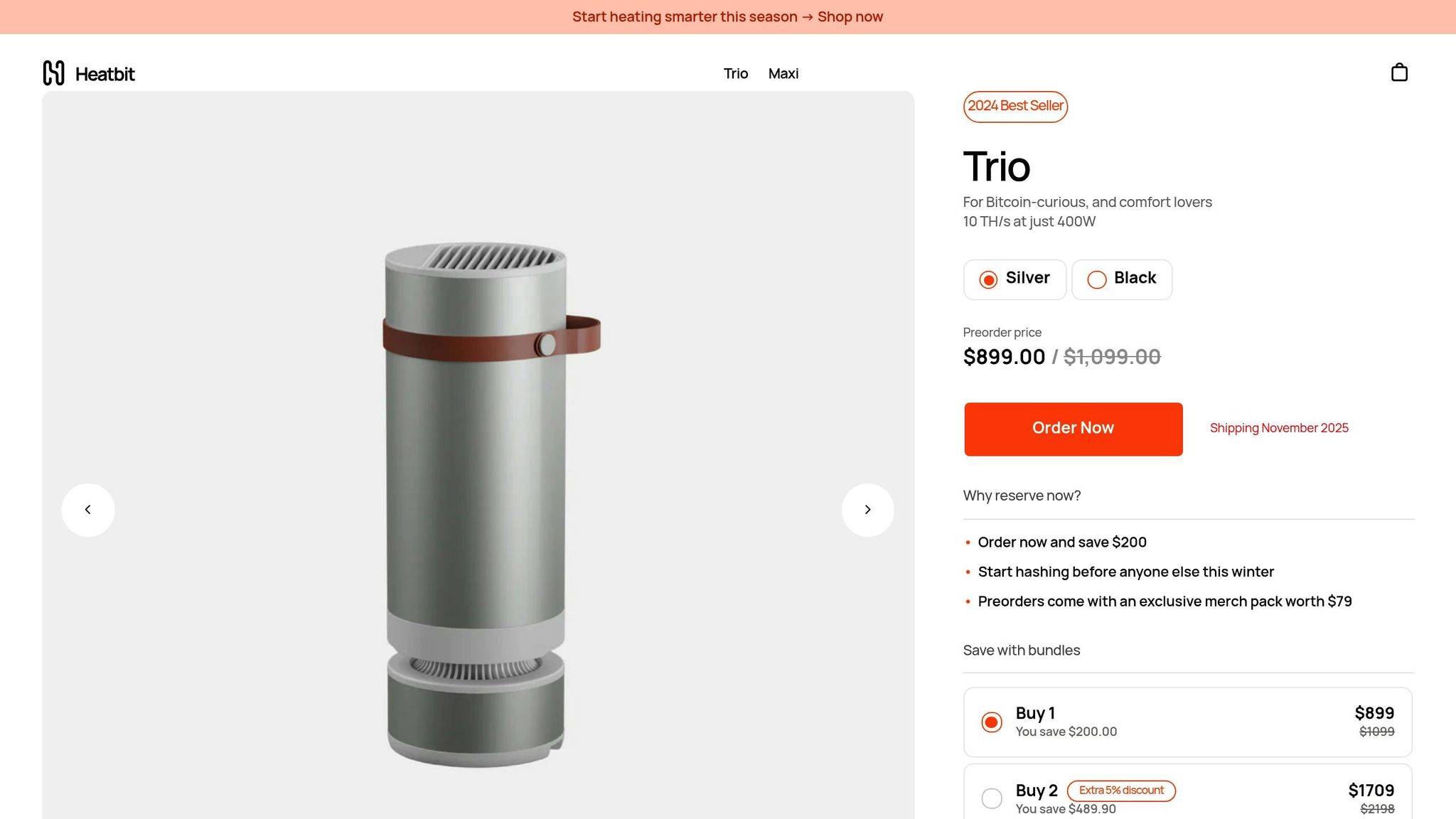
The Heatbit Trio is a Bitcoin miner designed to double as a home heater. At this time, specific details such as its power consumption, hashrate, efficiency, and noise levels haven't been disclosed.
For the most accurate and up-to-date information, it's best to refer directly to the manufacturer's documentation. We'll update this section as soon as additional details become available.
Now, let’s move on to the next model for a closer look at its performance and efficiency.
2. FutureBit Apollo II
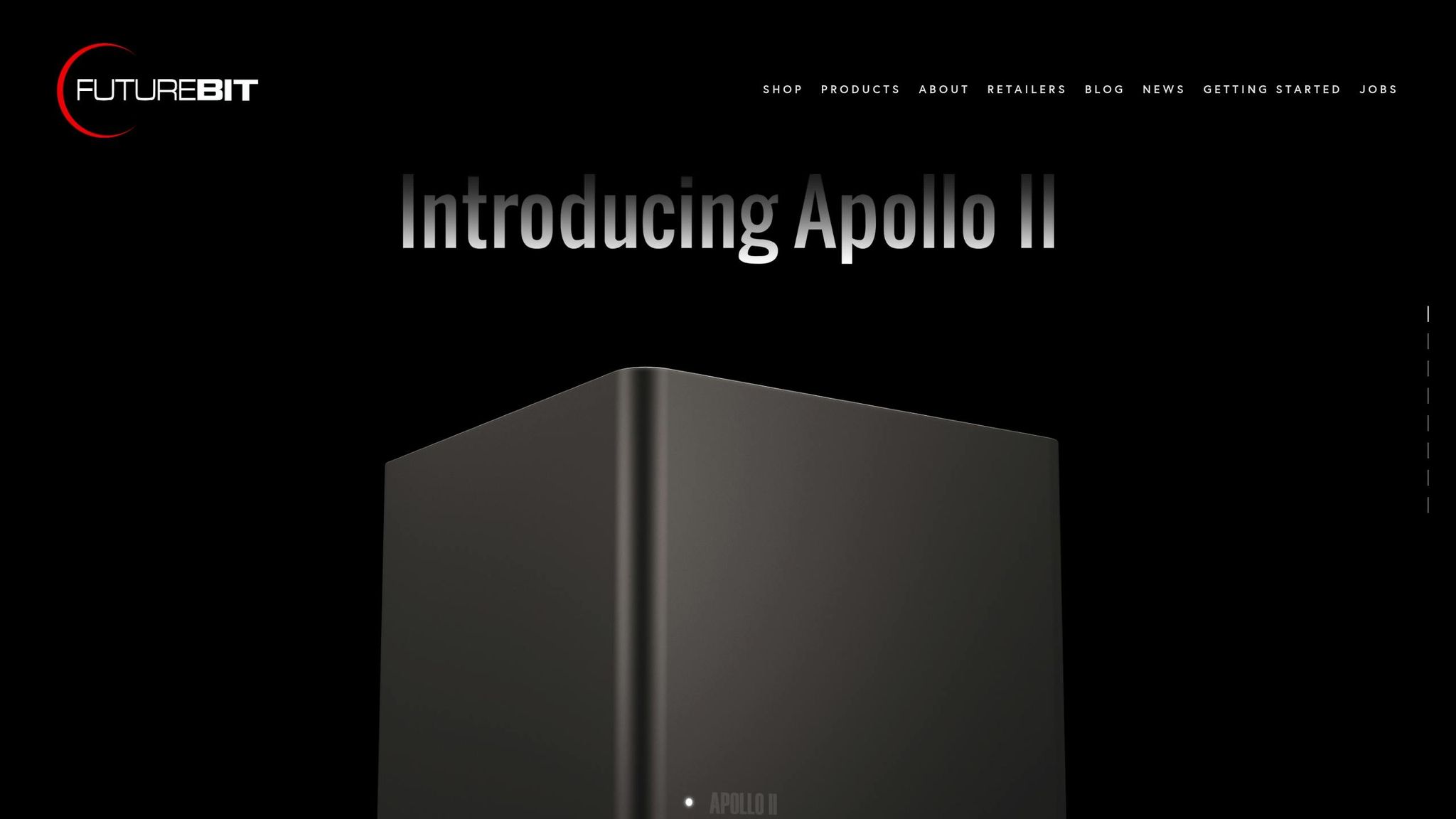
The FutureBit Apollo II is a compact Bitcoin miner tailored for home use, especially in setups where heating is a consideration. While detailed information about its power consumption, hashrate, efficiency, and noise levels is still being finalized, you can check the table above for the initial specifications.
Stay tuned for updates as more verified details become available. Now, let’s dive into the next model for further analysis.
3. FutureBit Apollo-BTC
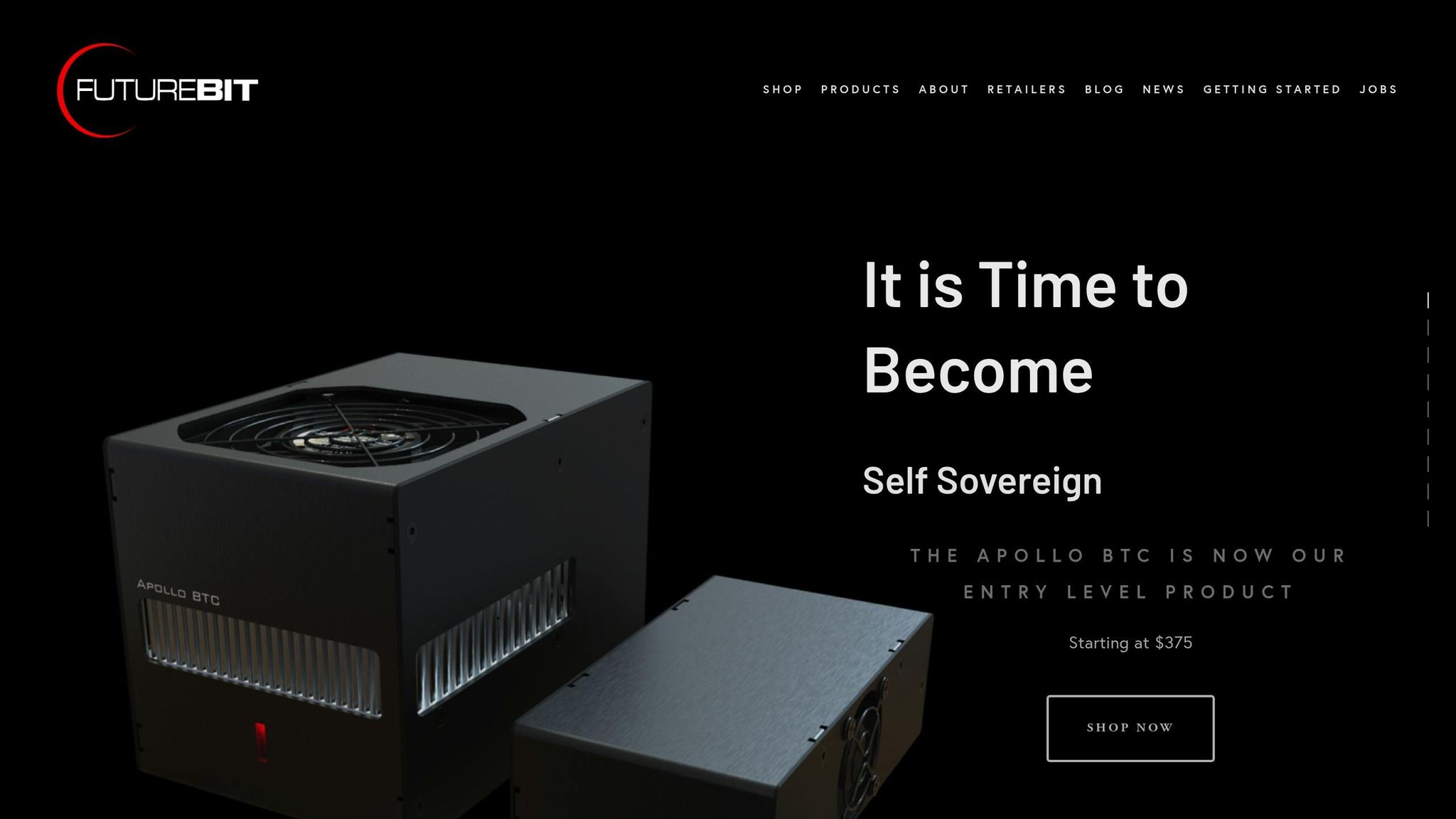
The FutureBit Apollo-BTC is a compact device tailored for combining Bitcoin mining with home heating, making it an excellent choice for residential use.
Power Consumption (W)
With a power draw of 200 watts, the Apollo-BTC is well-suited for home setups without significantly impacting your energy bill.
Hashrate (TH/s)
This device offers a hashrate of 3.8 TH/s, providing enough power to handle mining tasks while also contributing to heating your space.
Efficiency (W/TH or J/GH)
Its efficiency is rated at 52.63 W/TH (or 0.0526 J/GH), ensuring it meets the energy and heating needs of smaller setups effectively.
Noise Output (dB)
Running at approximately 25 dB in eco mode, this unit is quiet enough for use in living rooms, bedrooms, or home offices without causing disruptions. These features make the Apollo-BTC a practical and versatile option for residential environments, offering a balance of performance and comfort.
4. Braiins Mini Miner BMM-101
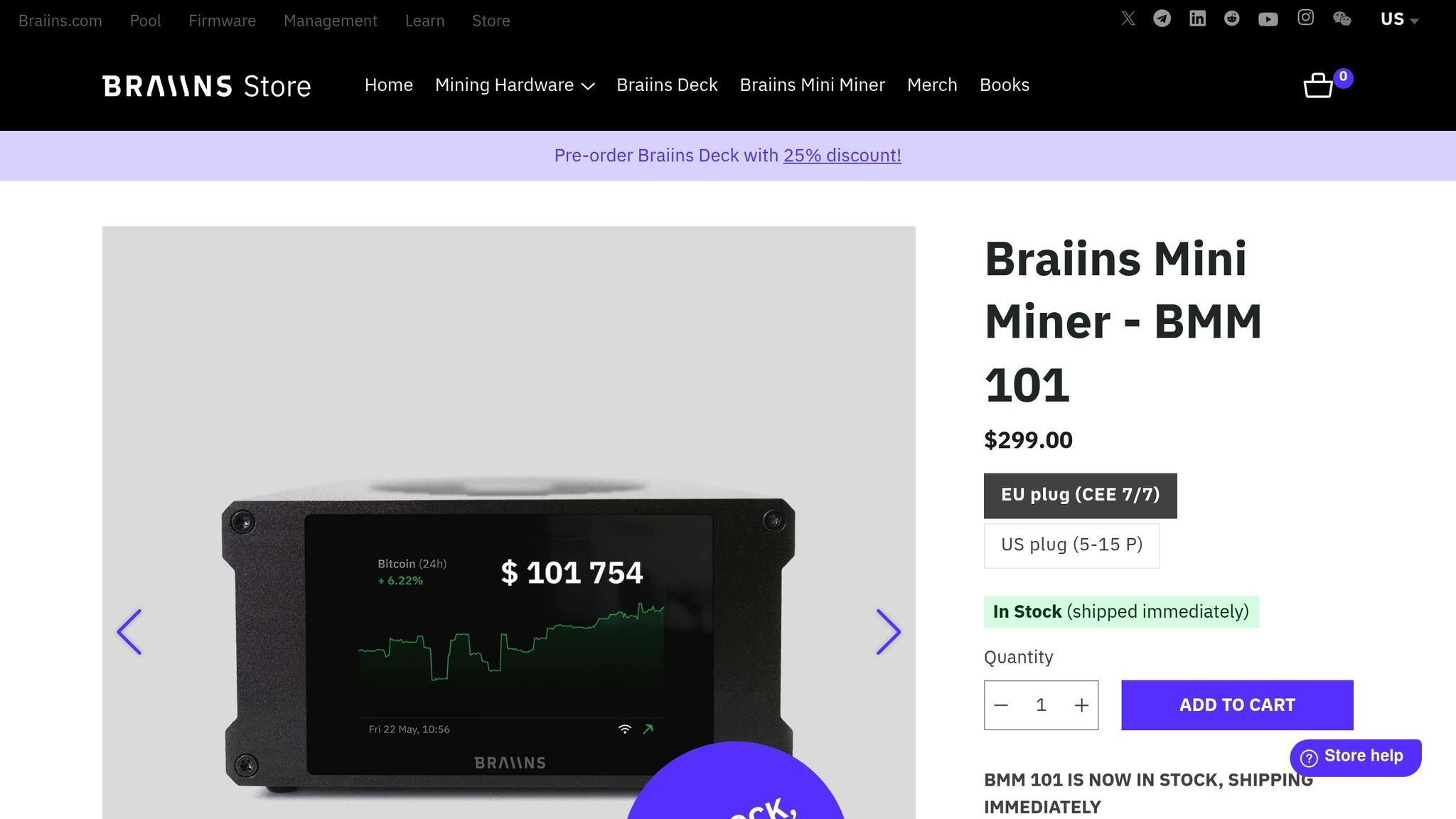
The Braiins Mini Miner BMM-101 is a beginner-friendly Bitcoin miner, perfect for those looking to dip their toes into mining while also enjoying a bit of extra home heating. Its small size and straightforward features make it an excellent choice for newcomers.
Power Consumption (W)
Running at just 40 watts, the BMM-101 uses minimal energy compared to bulkier mining rigs, making it an energy-conscious option.
Hashrate (TH/s)
This device offers a hashrate of 1.0 TH/s, which aligns well with its purpose as an entry-level miner.
Efficiency (W/TH or J/GH)
Its efficiency is rated at 40.0 W/TH (or 0.040 J/GH), striking a reasonable balance between performance and power usage.
Noise Output (dB)
With a noise level of approximately 40 dB, it operates quietly enough to fit comfortably in most homes without causing disruption.
Up next, we’ll take a closer look at a model that brings more power and efficiency to Bitcoin mining and heating.
5. Fluminer T3

The Fluminer T3 combines impressive mining performance with the added benefit of efficient home heating. Let’s break down its key features.
Power Consumption (W)
With a power draw of 1,700 watts, the Fluminer T3 sits in the mid-to-high range for mining equipment. While it uses more electricity than smaller home units, it’s less demanding than heavy-duty commercial miners like the Antminer S19. This level of power consumption also means it generates a significant amount of heat, making it a dual-purpose machine for both mining and home heating.
Hashrate (TH/s)
The T3 delivers a robust 115.0 TH/s, a performance level that easily surpasses entry-level models. It even outshines some high-end commercial units, including the Antminer S19, making it a powerful choice for serious miners.
Efficiency (W/TH or J/GH)
Operating at 14.78 W/TH (or 0.01478 J/GH), the Fluminer T3 is a leader in efficiency. It’s nearly seven times more efficient than the Antminer S9 and over twice as efficient as the Antminer S19. This means you’ll extract more mining power per watt of electricity, translating into higher Bitcoin yields and better heating efficiency for your home.
Noise Output (dB)
The noise level of the Fluminer T3 ranges between 50–55 dB, which is louder than some home-focused models. While it’s not ideal for living spaces, it’s manageable in basements or utility rooms where the sound won’t disrupt daily life.
With its combination of power, efficiency, and heat output, the Fluminer T3 stands out as a strong contender for those looking to mine Bitcoin while keeping their home warm.
6. Canaan Avalon Nano 3
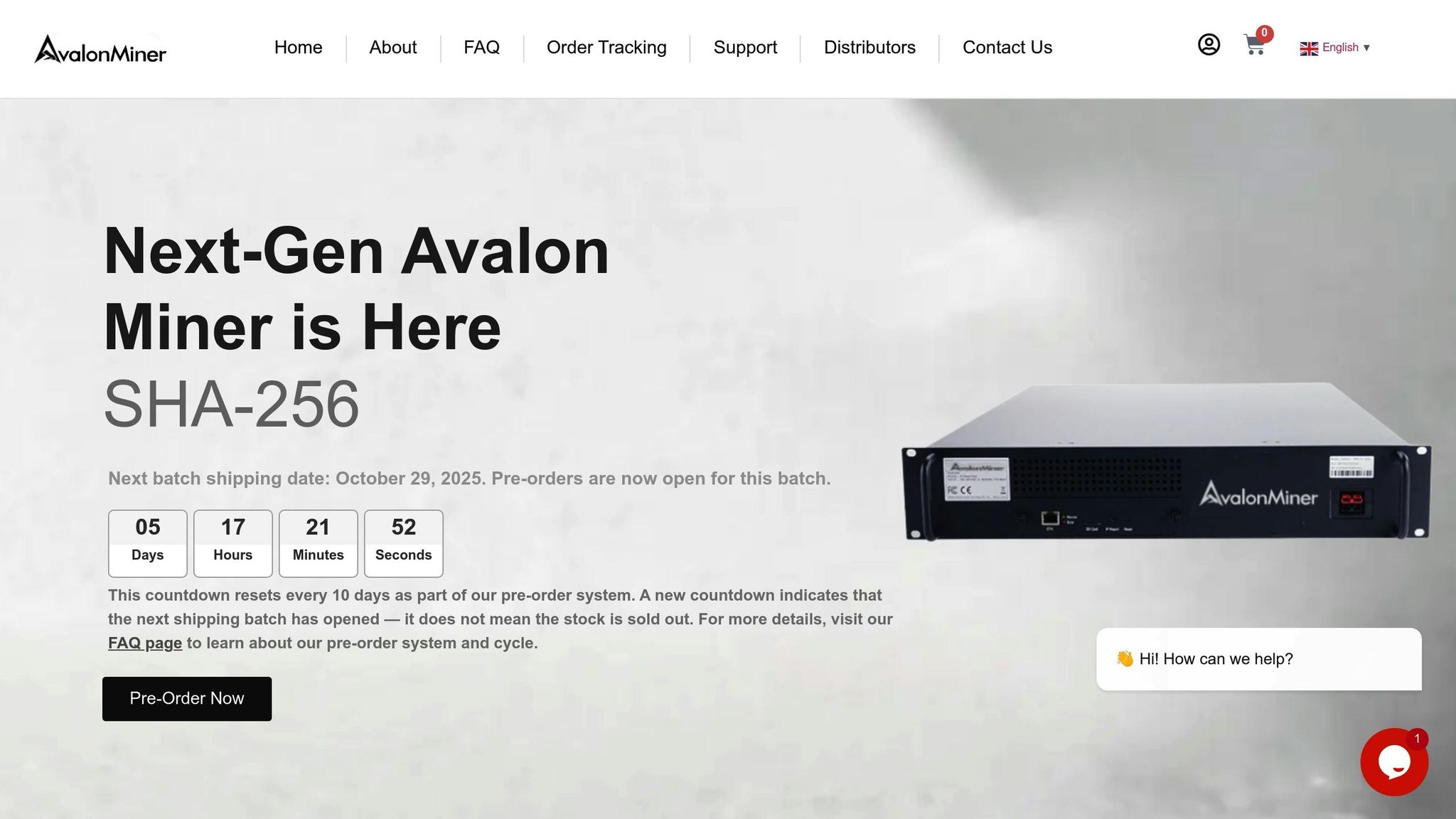
The Canaan Avalon Nano 3 serves as a versatile option for those interested in Bitcoin mining while also addressing their home heating needs. Designed with U.S. households in mind, it offers the convenience of combining these two functionalities. However, details about its power consumption, hashrate, efficiency, and noise output haven't been officially confirmed. This makes its performance largely dependent on manufacturer-provided estimates, which leaves some room for uncertainty.
In real-world use, the Nano 3 is said to provide consistent mining results while producing enough heat to warm a residential space. Its design prioritizes energy efficiency and operates quietly, making it a suitable choice for homes or shared work environments.
For the most accurate and up-to-date details, refer to the manufacturer's documentation and check our comparison table.
7. Canaan Avalon Nano 3S
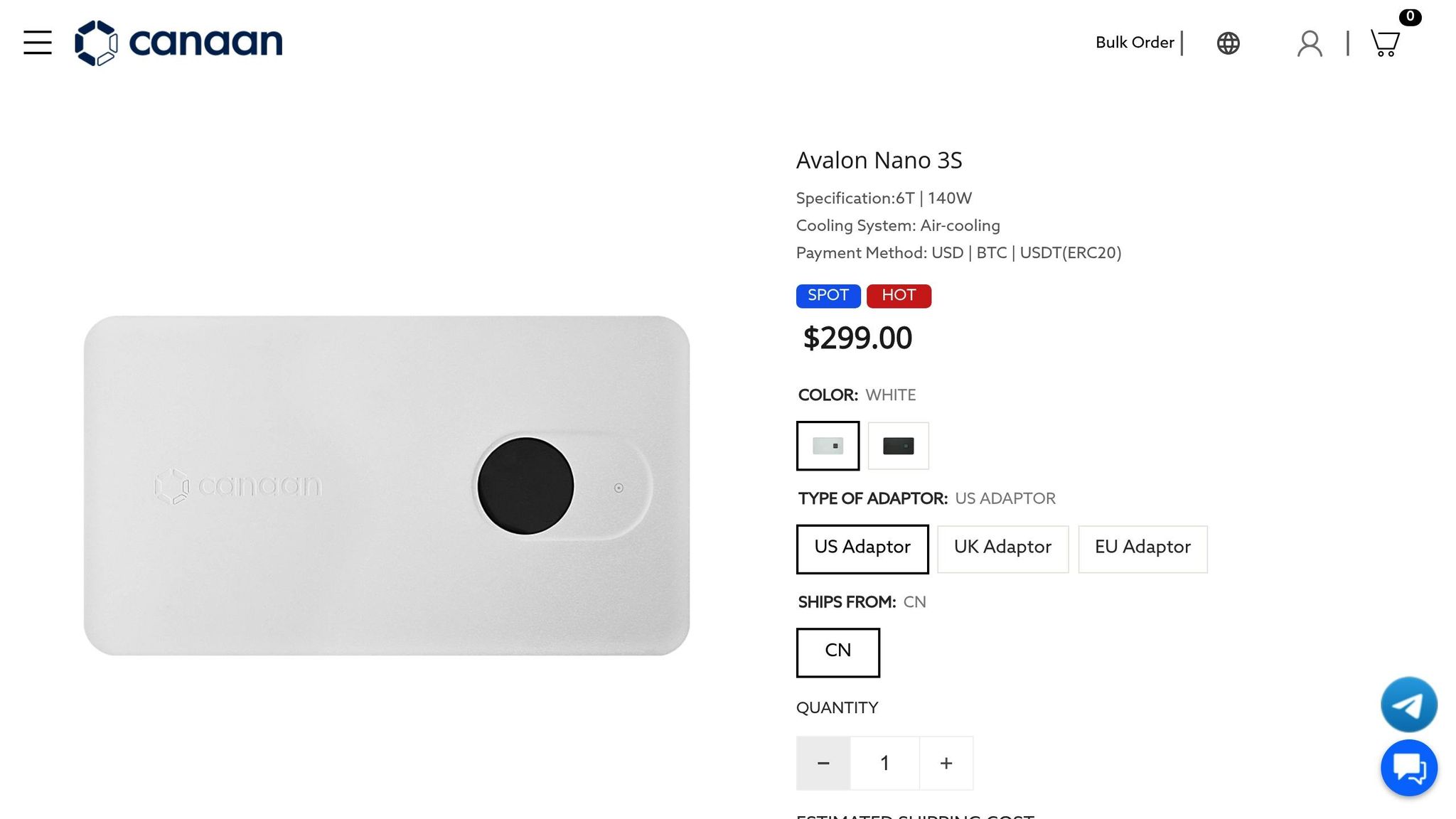
The Canaan Avalon Nano 3S takes an interesting approach by blending Bitcoin mining with residential heating. While the exact details on its power usage, hashrate, efficiency, and noise levels are still emerging due to limited manufacturer documentation, early insights hint at its potential to balance mining performance with home heating functionality.
Power Consumption (W)
Preliminary data suggests a power consumption of 140 W, though this figure awaits confirmation from the manufacturer.
Hashrate (TH/s)
The estimated hashrate is 6.0 TH/s, which could represent an upgrade over the earlier Nano 3 model.
Efficiency (W/TH or J/GH)
Initial estimates put its efficiency at 23.33 W/TH (or 0.02333 J/GH), offering a glimpse into its energy optimization capabilities.
Noise Output (dB)
Noise level specifics haven't been provided yet. For comparison, similar heater-mining devices like the Bitaxe Gamma 601 typically operate at around 35 dB. These early figures provide a foundation for assessing how well the Nano 3S can deliver on its dual-purpose design of efficient mining and home heating.
sbb-itb-c71a7d0
8. Canaan Avalon Mini 3
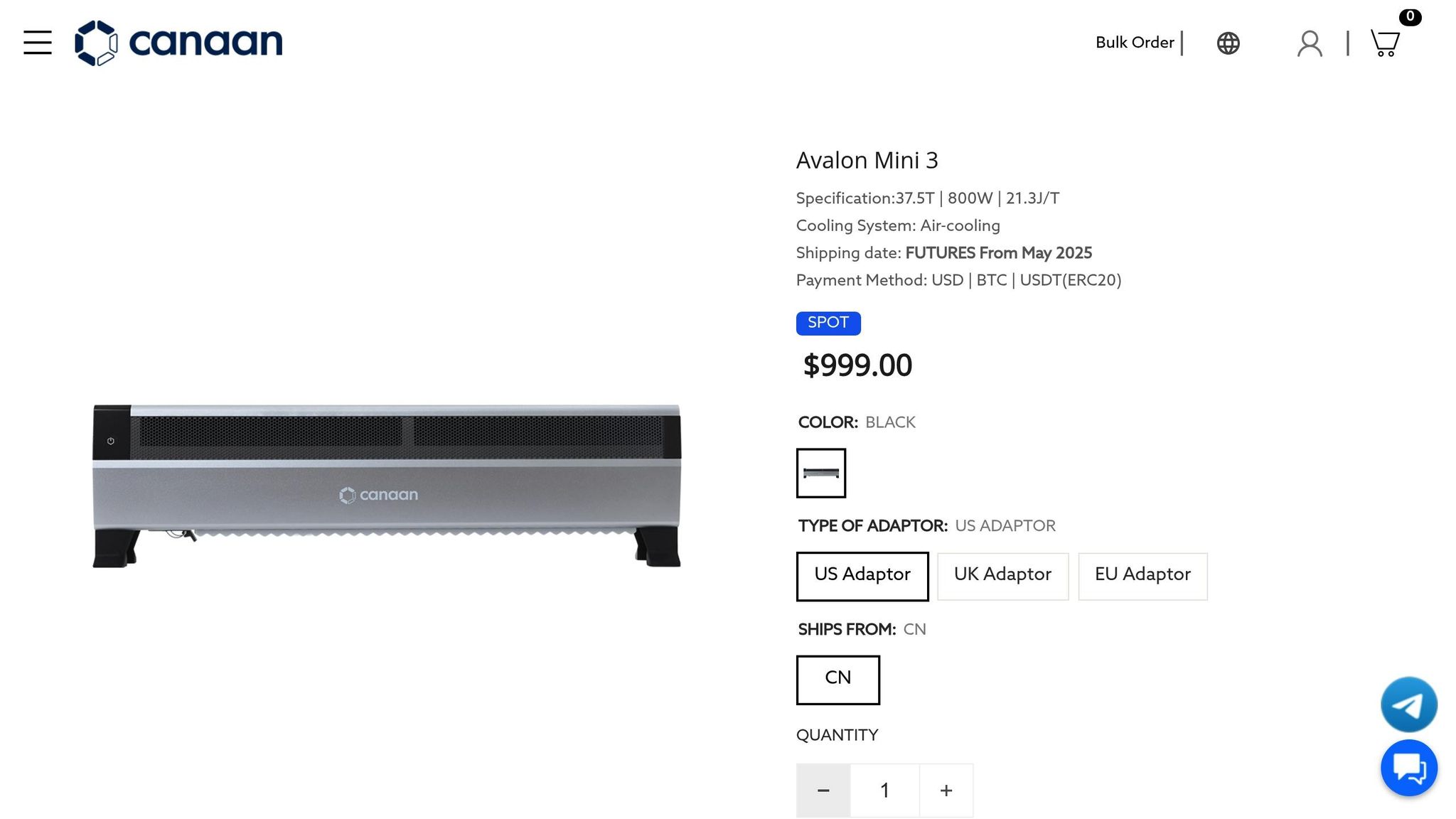
The Canaan Avalon Mini 3 is marketed as a dual-purpose device for Bitcoin mining and home heating. However, details about its power consumption, hashrate, efficiency, and noise levels are currently unavailable. For accurate and up-to-date specifications, it’s essential to refer to the manufacturer’s documentation. This uncertainty underscores the need to thoroughly assess and compare options when exploring mining equipment.
9. BitChimney (normal)
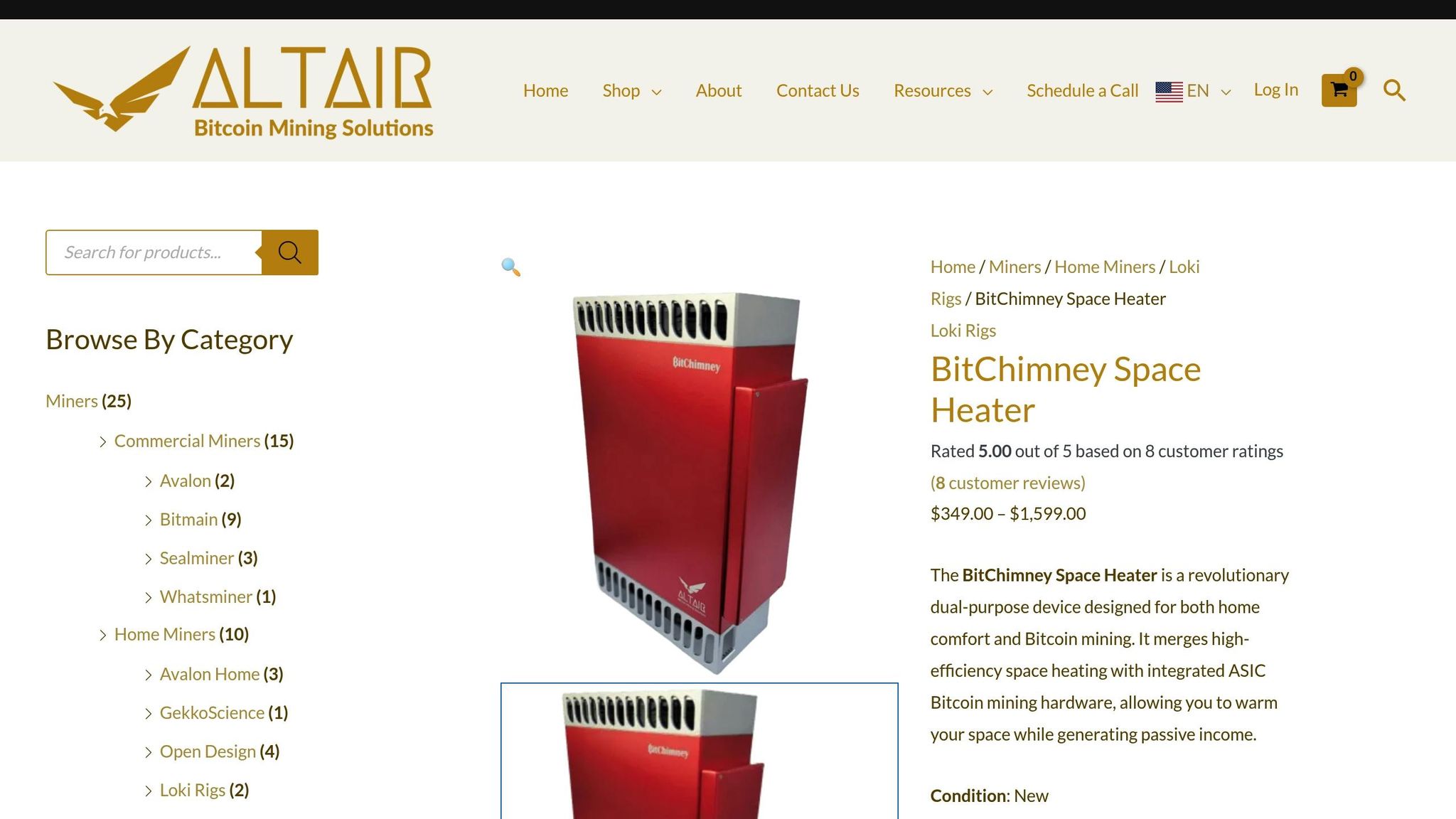
The BitChimney normal configuration strikes a balance between Bitcoin mining efficiency and practical home heating, continuing the trend of combining cryptocurrency mining with everyday functionality. Operating at 750 watts and delivering 40 TH/s of hashrate, this device is designed to heat residential spaces while contributing to Bitcoin mining.
Power Consumption (W)
The BitChimney uses 750 watts of power during operation. This places it in the mid-range category for energy consumption among similar devices. Running continuously, it consumes about 18 kWh per day, making it a manageable option for households looking to combine heating with mining.
Hashrate (TH/s)
With a hashrate of 40 TH/s, the BitChimney offers solid mining performance. This level of output positions it as a powerful contender in the home heating miner market. Its mining capability not only supports the Bitcoin network but also provides a practical way to warm living spaces.
Efficiency (W/TH or J/GH)
The BitChimney achieves an efficiency of 18.75 W/TH (0.01875 J/GH). While this efficiency ensures effective mining performance, all the energy consumed is ultimately converted into heat, making it a practical choice for residential heating. This combination of performance and utility makes it a strong option for home use.
Noise Output (dB)
The device operates at a noise level of 49 dB, which is moderate for Bitcoin mining equipment. It’s quieter than industrial miners but louder than ultra-quiet models like the FutureBit Apollo-BTC in eco mode (25 dB). At 49 dB, the sound is similar to light rainfall or the ambiance of a quiet office, making it suitable for home environments without being overly disruptive.
10. BitChimney (high)
The BitChimney (high) model takes the standard configuration and pushes it further, offering a noticeable 32.5% boost in mining performance. This premium version is designed for those who need more power and efficiency in their mining operations.
Power Consumption (W)
This model draws 1,000 watts of power. If you run it continuously, that equals about 24 kWh per day. The extra power supports its higher computational output and also generates heat as a byproduct.
Hashrate (TH/s)
The BitChimney (high) delivers a hashrate of 53 TH/s, giving it a clear edge over the normal version in terms of computational power.
Efficiency (W/TH or J/GH)
It runs at an efficiency of 18.87 W/TH (or 0.01887 J/GH), which is slightly better than the standard model's 18.75 W/TH. This small improvement adds to its overall performance.
Noise Output (dB)
Noise levels for this model are measured at 56 dB, as noted in the comparison table.
11. Bitmain Antminer R4

The Bitmain Antminer R4 is one of the earlier Bitcoin miners designed with home use in mind. However, details about its power consumption, hashrate, efficiency, and noise levels remain unverified. Without this crucial information, it's difficult to assess whether this model is a good fit for Bitcoin heating purposes.
Points to Keep in Mind for Home Use
Although marketed for home environments, the absence of confirmed specifications makes it challenging to recommend the Antminer R4 with confidence. Let’s move on to the next model, which offers more concrete performance data.
12. Antminer S9
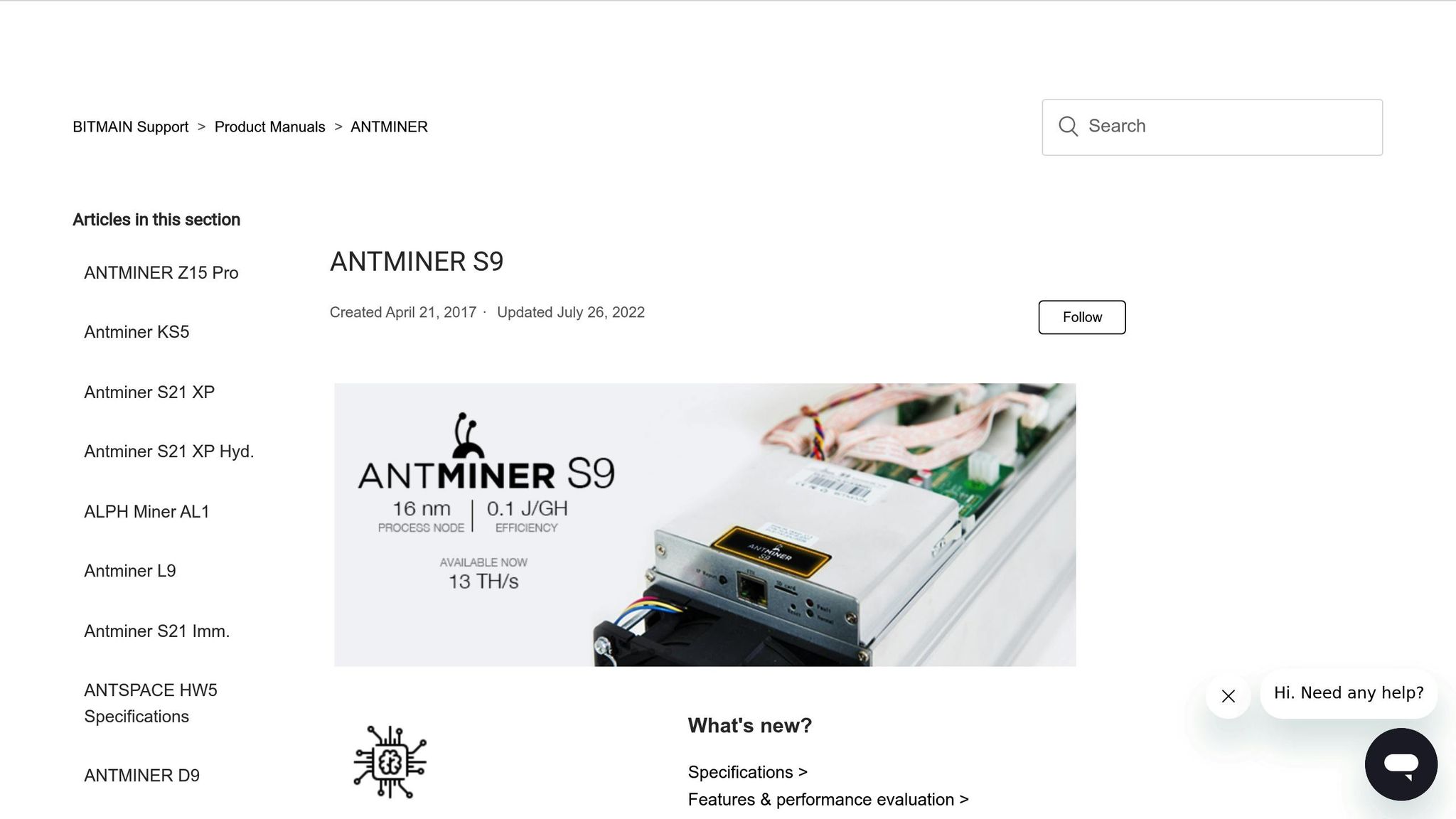
Released in September 2017, the Bitmain Antminer S9 was once a popular choice for Bitcoin mining. However, by 2026, its aging efficiency makes it a less practical option for Bitcoin heating.
Power Consumption (W)
The Antminer S9 consumes 1,323 watts of power during operation. This places it in the middle range compared to other miners. It uses more power than smaller home-oriented models, like the FutureBit series, but less than industrial-grade units such as the Antminer S19.
Hashrate (TH/s)
With a hashrate of 13.5 TH/s, the S9 was competitive during its prime. However, modern devices have far surpassed this output, leaving the S9 behind in terms of performance.
Efficiency (W/TH or J/TH)
The S9’s efficiency is 98 J/TH, which pales in comparison to newer models like the Antminer S19 (34 J/TH) and the Bitaxe Gamma 601 (14 J/TH). This significant gap highlights its inefficiency for Bitcoin heating in 2026.
Noise Output (dB)
Operating at around 85 dB, the S9 is quite loud. This noise level can make it challenging to use in residential spaces without causing disturbances.
Profitability Concerns for 2026
The S9’s inefficiency and noise output also affect its economic appeal. As of October 2025, the S9 incurs a daily loss of $1.55, assuming electricity costs of $0.07/kWh. This negative profitability trend is expected to continue into 2026, making the S9 an expensive option for generating heat.
13. Antminer S19 (model 240-Ca)

The Bitmain Antminer S19 model 240-Ca is a powerful ASIC miner built for industrial-scale Bitcoin mining and heating projects. Its design not only ensures efficient Bitcoin mining but also generates substantial heat, making it suitable for large-scale heating applications.
Here’s a closer look at the key features that make the S19 a solid choice for industrial operations.
Power Consumption
The S19 consumes 3,250 W of power, delivering impressive mining capabilities while producing significant heat. This makes it particularly effective for warming large spaces as part of industrial heating setups.
Hashrate
With a hashrate of 95 TH/s, the S19 is a top-tier performer in Bitcoin mining. This level of performance ensures steady and high-volume mining, making it ideal for industrial environments where reliability is crucial.
Efficiency
The S19 achieves an efficiency rating of 34.21 W/TH (or 0.03421 J/GH). To put this into perspective, older models like the Antminer S9 and Antminer R4 operate at 98 W/TH (0.0980 J/GH) and 99.41 W/TH (0.09941 J/GH), respectively. While it doesn’t match the efficiency of the Bitaxe Gamma 601, which operates at 14.17 W/TH, the S19 strikes a balance between high performance and reasonable energy efficiency for industrial use.
Noise Output
Bitmain’s official specifications for the S19 model 240-Ca do not include a noise level rating. However, users should anticipate typical industrial noise levels. To ensure a comfortable working environment, effective cooling and soundproofing measures are recommended.
Advantages and Disadvantages
This section dives into the benefits and trade-offs of various Bitcoin heating miners, focusing on performance, efficiency, noise levels, and installation factors. These comparisons build on the detailed performance metrics discussed earlier.
Home-friendly models like the Heatbit Trio and FutureBit Apollo-BTC shine for residential use, offering ultra-quiet operation. However, their heat output is relatively modest, which might not be sufficient for larger spaces.
Energy efficiency leaders are ideal for users who prioritize low power consumption. These models, such as the Canaan Avalon Nano 3S, strike a balance with moderate heat output, making them suitable for smaller spaces or energy-conscious households.
Industrial units like the Antminer S19 and Fluminer T3 are designed for large-scale operations. They excel at generating significant heat but come with higher noise levels and demand specialized electrical setups. For example, the Fluminer T3 operates at 50–55 dB, which may not be ideal for quiet residential settings.
Legacy devices offer a mix of pros and cons. While their lower upfront costs appeal to budget-conscious buyers, they tend to lag in efficiency and produce more noise, making them less practical for modern needs.
| Model Category | Best For | Main Advantage | Primary Drawback |
|---|---|---|---|
| Home Miners (Heatbit, Apollo-BTC) | Residential heating | Ultra-quiet operation | Limited heat output |
| Efficiency Leaders (Bitaxe, Avalon Nano 3S) | Energy-conscious users | Low power consumption | Moderate hashrates |
| Industrial Units (S19, Fluminer T3) | Large-scale projects | Maximum heat generation | High noise and power demands |
| Legacy Models (S9, R4) | Budget-conscious buyers | Lower upfront costs | Poor efficiency and high noise |
Noise levels play a crucial role in usability. Models operating below 40 dB are well-suited for living areas, while those exceeding 50 dB are better suited for dedicated rooms or industrial setups. For instance, the BitChimney series highlights this trade-off: its normal mode operates at 49 dB with 750 W, but the high mode jumps to 56 dB at 1,000 W.
Power requirements also vary significantly. Entry-level units like the Braiins Mini Miner need only 40 W and can easily plug into standard household outlets. On the other hand, high-power models like the Antminer S19 require 3,250 W and specialized electrical configurations.
It's worth noting that higher heat output doesn’t necessarily mean better efficiency. The most energy-efficient miners often produce less usable heat, while less efficient models tend to generate more raw thermal energy.
Installation complexity ranges from simple plug-and-play setups to more involved processes requiring 240V outlets, cooling systems, and noise control. Smaller units are typically easier to install, while industrial-grade models demand a more advanced setup.
Choosing the right miner means finding the right balance between energy efficiency, heat output, and installation needs to match your specific home heating goals.
Conclusion
Finding the right Bitcoin heating miner is all about balancing your heating requirements with performance and energy efficiency across more than 13 available models.
For quieter spaces like bedrooms or home offices, options such as the FutureBit Apollo-BTC are ideal with their ultra-low noise levels. If you need more heat for larger areas, the Heatbit Trio steps up with higher heat output while still being suitable for residential use.
For those focused on energy efficiency, the Canaan Avalon Nano 3S offers a solid 23.33 W/TH, though its noise level isn't specified. On the other hand, the Bitaxe Gamma 601 shines with an impressive 14.17 W/TH efficiency and a quiet 35 dB noise level, though its smaller heat output reflects its modest 17 W power consumption.
If maximizing heat is your top priority, industrial models like the Fluminer T3 (1,700 W) provide significant thermal energy with a noise range of 50–55 dB. The Antminer S19, with its hefty 3,250 W power draw, is built for industrial-scale heating. While its noise rating isn’t listed, its heavy-duty design suggests it’s not suited for quiet environments. Both models require specialized electrical setups and proper ventilation to operate safely.
For budget-conscious buyers, older models like the Antminer S9 could be an option. However, its low efficiency (98 W/TH) and loud operation (around 85 dB) make it less appealing for most homes.
The BitChimney series offers versatility with two operation modes. In normal mode, it consumes 750 W and maintains a manageable 49 dB noise level, suitable for dedicated heating spaces. Its high mode, running at 1,000 W and producing 56 dB, is better for situations where heat output takes precedence over noise.
Mid-range models may strike the best balance for many U.S. homeowners. For example, the Canaan Avalon Mini 3 operates at 800 W, delivering substantial warmth while keeping noise levels between 33 and 55 dB - making it a practical choice for home heating. With such a wide range of options, selecting the right miner means tailoring your choice to your home’s specific needs and environment.
FAQs
What is the best Bitcoin mining hardware for heating your home?
When picking Bitcoin mining hardware that doubles as a home heating solution, there are a few important things to think about:
- Power Consumption: The more electricity a miner uses, the more heat it produces - but this also means higher energy bills. For instance, the Antminer S9 draws about 1,323 W, while the Bitaxe Gamma 601 is far more energy-efficient, using just 17 W.
- Efficiency: Efficiency is key when it comes to balancing heat output and mining performance. Look for models with a lower wattage per terahash (W/TH) or joules per gigahash (J/GH). Devices like the Bitaxe Gamma 601 are designed to generate less heat per unit of work, making them a practical choice.
- Noise Level: Noise can be a dealbreaker in a home environment. Some miners, like the Bitaxe Gamma 601, operate at a quiet 35 dB, making them ideal for living spaces. In contrast, louder models, such as the Antminer S9 (around 85 dB), might be better suited for garages or basements.
Finding the perfect hardware depends on your specific needs - whether that’s heating efficiency, energy costs, or how much noise you can tolerate in your home.
How energy-efficient are Bitcoin miners when used for home heating?
The energy efficiency of Bitcoin miners is a key factor in determining how well they can double as home heating devices. Efficiency is measured in Watts per terahash (W/TH) - the lower the number, the better the performance. For instance, the Antminer S9 operates at 98 W/TH, while the more advanced Antminer S19 offers a significant improvement at 34.21 W/TH. Even more impressive, the Bitaxe Gamma 601 achieves an efficiency of just 14.17 W/TH.
Miners with higher efficiency produce less heat for the same amount of computational work, which makes them ideal for balancing energy consumption with heating output. Opting for an efficient miner allows you to get the most out of both Bitcoin mining and home heating, all while cutting down on wasted energy.
What electrical setup is needed to use industrial-grade Bitcoin miners at home?
Using industrial-grade Bitcoin miners at home isn't as simple as plugging them in - it takes some planning. These machines consume a lot of power, so you'll need to ensure your home's electrical system can handle the demand. Since most miners run on 220-240V circuits, you might need to install a dedicated circuit or even upgrade your electrical panel. It's a good idea to bring in a licensed electrician to check everything for safety and compatibility.
Beyond electricity, think about heat and noise. These miners generate a lot of both, so proper ventilation and cooling are critical to avoid overheating. And don’t underestimate the noise - they can be loud enough to disrupt your living space. You might want to set them up in a soundproofed or isolated area. Always review the miner's specifications and power needs before setting up to steer clear of potential problems.

